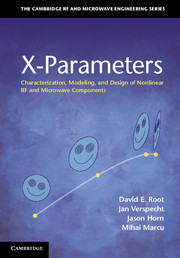Book contents
- Frontmatter
- Contents
- Preface
- Acknowledgments
- 1 S-parameters – a concise review
- 2 X-parameters – fundamental concepts
- 3 Spectral linearization approximation
- 4 X-parameter measurement
- 5 Multi-tone and multi-port cases
- 6 Memory
- Appendix A Notations and general definitions
- Appendix B X-parameters and Volterra theory
- Appendix C Parallel Hammerstein symmetry
- Appendix D Wide-band memory approximation
- Appendix E Solutions to exercises
- Index
- References
3 - Spectral linearization approximation
Published online by Cambridge University Press: 05 October 2013
- Frontmatter
- Contents
- Preface
- Acknowledgments
- 1 S-parameters – a concise review
- 2 X-parameters – fundamental concepts
- 3 Spectral linearization approximation
- 4 X-parameter measurement
- 5 Multi-tone and multi-port cases
- 6 Memory
- Appendix A Notations and general definitions
- Appendix B X-parameters and Volterra theory
- Appendix C Parallel Hammerstein symmetry
- Appendix D Wide-band memory approximation
- Appendix E Solutions to exercises
- Index
- References
Summary
Simplification of basic X-parameters for small mismatch
The considerations used for the definition of X-parameters apply to the steady-state behavior of time-invariant nonlinear components with incident (and hence also scattered) waves on a harmonic frequency grid. The generality of the formalism comes at the cost of considerable complexity. Each spectral map is a nonlinear function of every applied DC-bias condition and all the magnitudes and phases of each spectral component of every signal at every port. Sampling such behavior in all variables for many ports and harmonics would be prohibitive in terms of data acquisition time, data file size, and model simulation speed.
Fortunately, in most cases of practical interest, only a few large-signal components need to be considered with complete generality, while most spectral components can be considered small and dealt with by methods of perturbation theory. Specifically, we can apply the following methodology.
Identify the few large tones that drive the main nonlinear behavior of the system.
Identify the nonlinear spectral map defined when only these few large tones drive the system (without any of the other tones identified as small-level signals). This nonlinear spectral map represents a specific steady state the system arrives at due to the large-signal stimulus.
Linearize the spectral maps around this specific steady state defined by the few important large tones.
Consider all the rest of the signals (the small signals) to be treated linearly based on the linearized map.
- Type
- Chapter
- Information
- X-ParametersCharacterization, Modeling, and Design of Nonlinear RF and Microwave Components, pp. 45 - 87Publisher: Cambridge University PressPrint publication year: 2013



